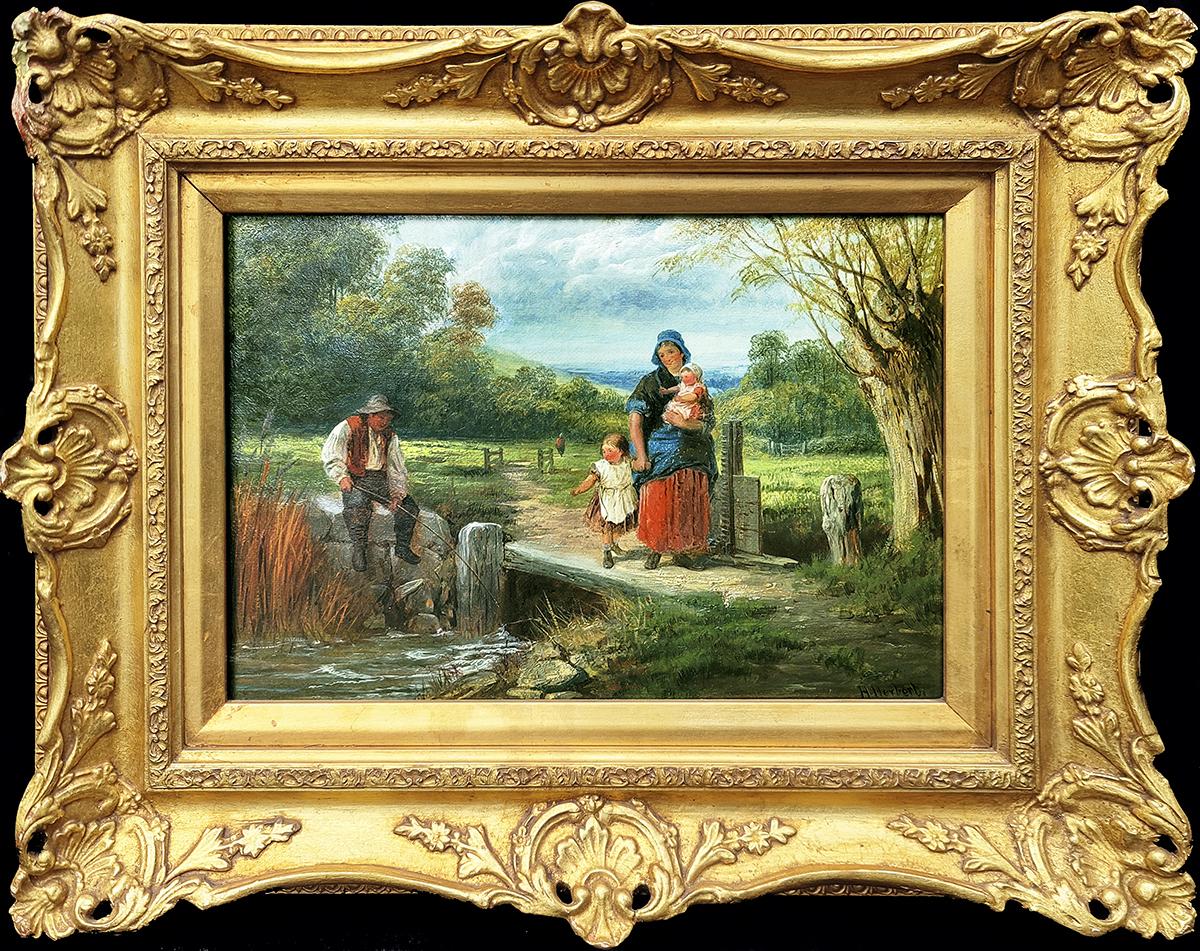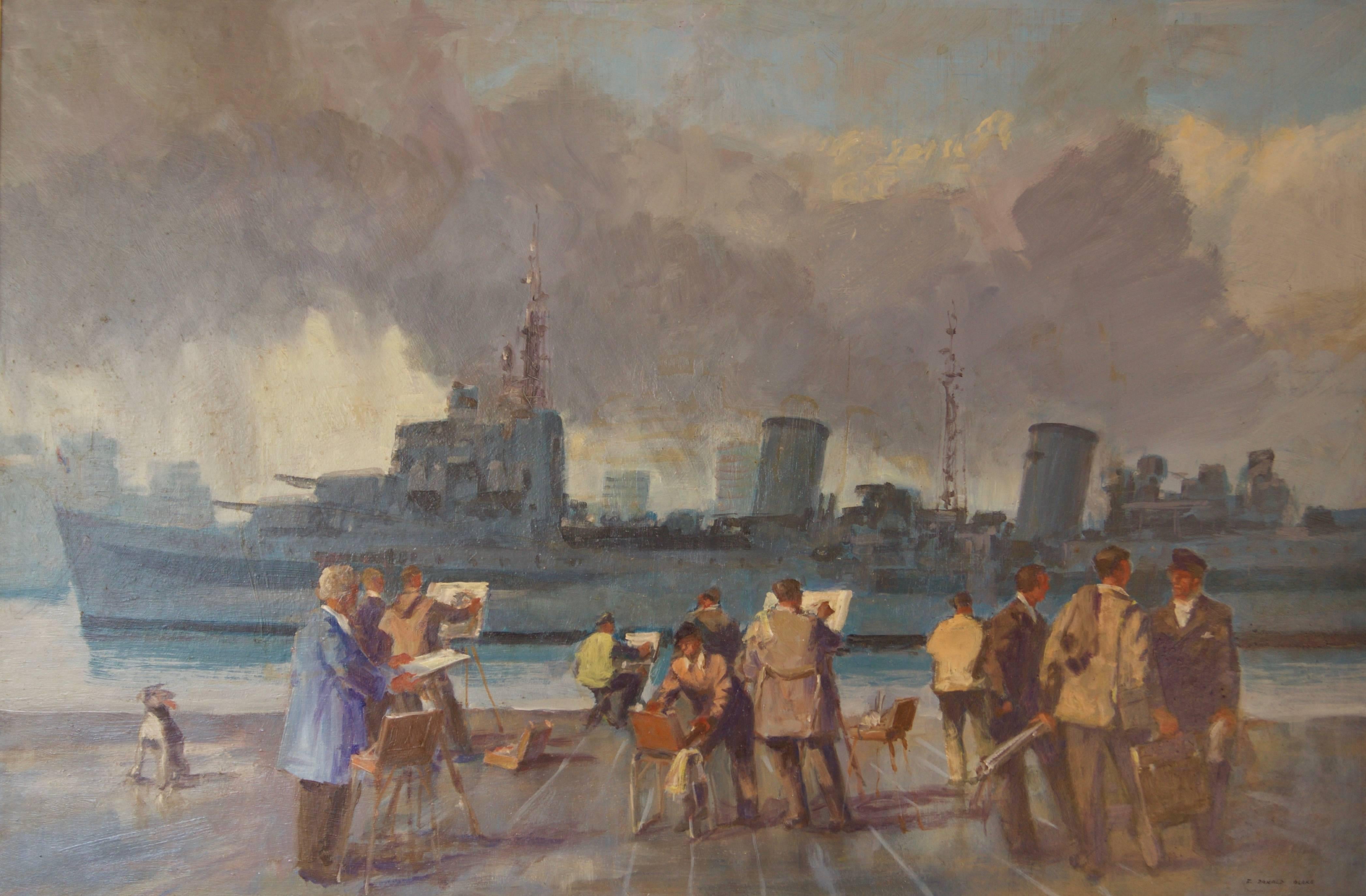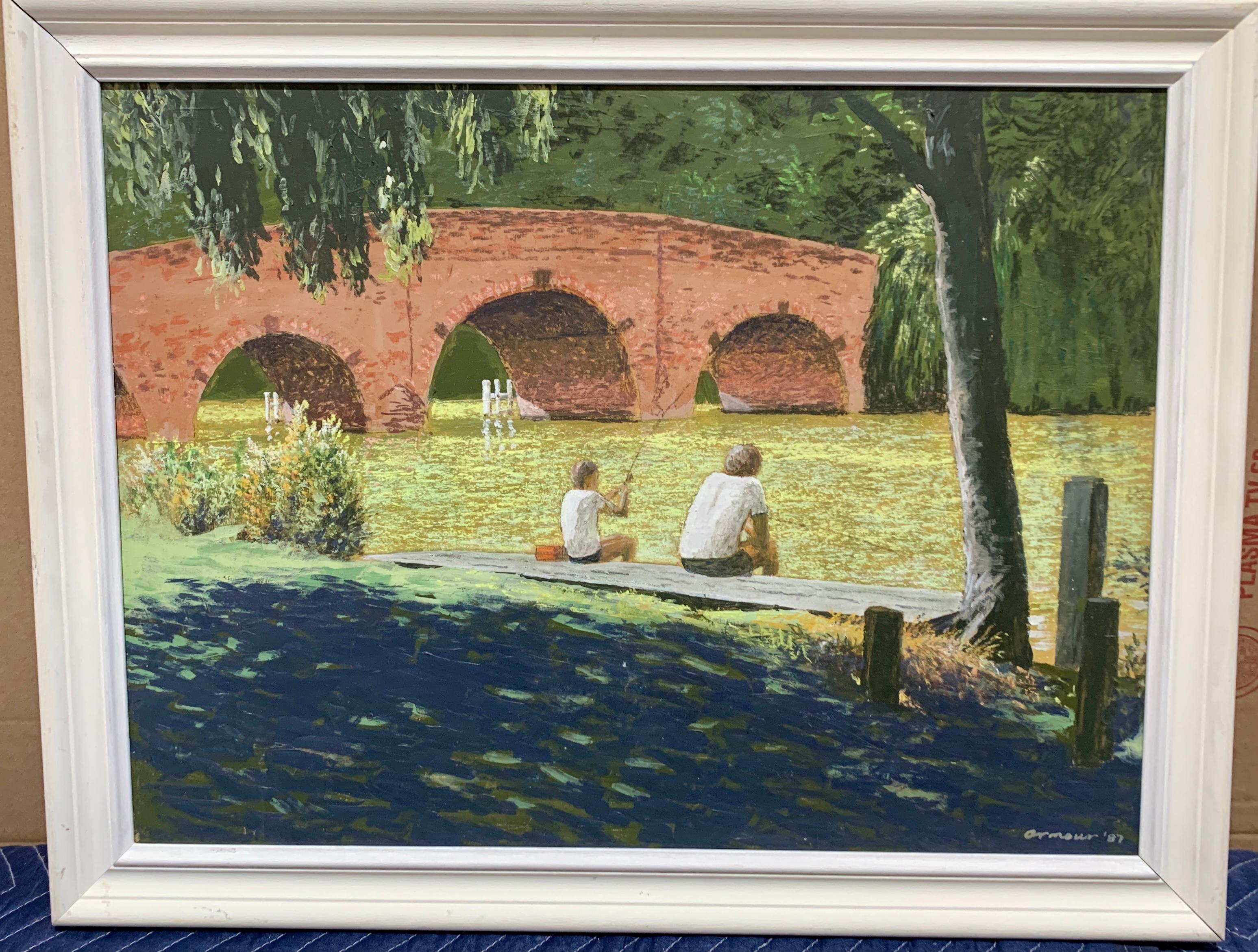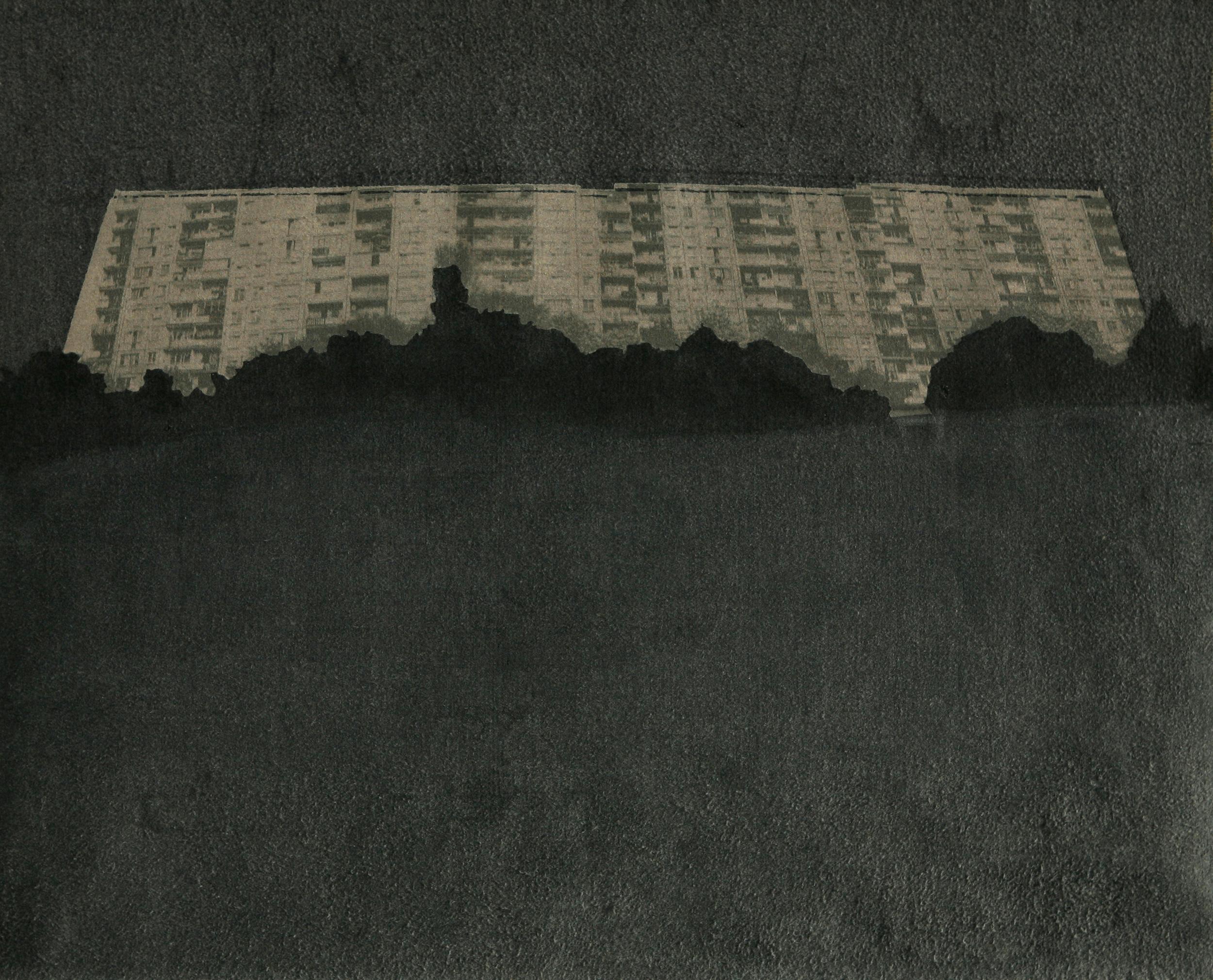Items Similar to Allegory of four elements, pupil of Jan Brueghel the Younger (1601-1678)
Want more images or videos?
Request additional images or videos from the seller
1 of 18
Allegory of four elements, pupil of Jan Brueghel the Younger (1601-1678)
About the Item
17th century Antwerp school
Landscape, animals and stilllife by a pupil of Jan Brueghel the Younger (1601-1678)
Figures by a pupil of Frans Francken II
Oil on canvas: h. 52,5 cm, w. 82 cm (11
Giltwood frame
Framed: h. 66 cm, w. 96 cm
Our magnificent painting has as its subject a theme frequently treated in the 17th century, the allegory of the four elements which make up the universe: air, water, fire and earth.
The elements are personified by four mythological figures gathered in the heart of a lush landscape, each with their own attribute.
Ceres symbolizing agriculture and abundance is seated on the right holding a cornucopia. On the left Amphitrite holds a conch shell from which water and fish flow, Urania holds an armillary sphere, symbolizing air. While Vesta, in profile, with her back turned to the viewer, holds a flaming torch.
The composition is divided in two, the forest landscape and the watercourse lined with reeds flowing into the sea.
This separation is accentuated by the still life of flowers, fruits and vegetables on the right balanced by the artistic dispersion of shells and fish on the left.
Finally, the upper left corner is occupied by the air domain: on the bare branches of a tree the different birds are gathered. Other birds fly over the sky. Two intertwined puttis hover above the waters, one equipped with a torch and the other with an armillary sphere.
In the background in the sea Neptune drives his chariot drawn by sea horses.
Our artist strives to paint the splendors of nature with remarkable realism and works meticulously to make fruits, vegetation, birds and marine animals as real as possible.
All the figures, animals, objects and the landscape thus form an idyllic scene representing in a microcosm the entire universe and by extension divine creation in all its splendor.
Beyond an aesthetic pleasure of contemplating the universe, the artist with an encyclopedic spirit like a naturalist or botanist lists the vegetables and fruits placed at the feet of the goddesses, as well as the different flowers that grow on the right .
Of course, this favorite subject of painters from the beginning of the 17th century required a mastery of several genres: human figures, still life as well as landscape, which explained the intervention of two artists.
Our painting is a collaborative work between two students of Antwerp artists: Jan Brueghel the Younger (the specialist in landscape and still life) and Frans Francken II (figure painter), the masters having worked together on several occasions to depict the theme of four elements, it is obvious that they had to delegate certain increasingly numerous orders to the members of their respective workshops.
For the allegories of the four elements executed jointly by Jan Brueghel the Younger and Frans Francken II see below:
Related works:
• Sotheby's (London (England)) 2014-07-10, 51 x 65 cm, oil on canvas, Jan Brueghel the Youngher & Frans Francken II
• Getty Museum, Los Angeles, Jan Brueghel the Younger & Frans Francken II, oil on panel 52,7 x 81,3 cm (inv 71.PB.28), 1635
• Schwerin Staatliches Museum, workshop of Frans Francken II, oil on panel (31x42 cm) (the figures on this painting are very similar to our work)
• Auction house Sophie Himbaut, Aix en Provence, 19/03/2021, oil on panel, 55 x 75 cm, Jan Brueghel the Younger and pupil of Frans Francken II
The first known painting dealing with the theme of the “four elements” by Jan Brueghel the Elder was painted in 1604 for Rudolph, Holy Roman Emperor (kept at the Kunsthistorisches Museum in Vienna, inv GG815).
This work provided the impetus for a great tradition of the theme of the four elements in Antwerp painting, painted mainly by Jan Brueghel the Younger, sometimes divided into four independent works for each element.
This methodical organization is reminiscent of the context of wunderkammers (cabinets of curiosities) and the rise of collecting in the 17th century.
According to a theory which indicates that all materials present on our globe are reducible to four elements: earth, water, air and fire. This theory, amply described by the Greek philosopher Aristotle, was abandoned during the 18th century following progress in chemistry.
- Dimensions:Height: 25.6 in (65.03 cm)Width: 37.8 in (96.02 cm)
- Medium:
- Movement & Style:
- Circle Of:Jan Brueghel the Younger (1601 - 1678, Flemish)
- Period:Mid-17th Century
- Condition:
- Gallery Location:PARIS, FR
- Reference Number:1stDibs: LU2433214081532
About the Seller
No Reviews Yet
Vetted Seller
These experienced sellers undergo a comprehensive evaluation by our team of in-house experts.
1stDibs seller since 2023
Typical response time: 1 hour
- ShippingRetrieving quote...Ships From: PARIS, France
- Return PolicyA return for this item may be initiated within 3 days of delivery.
More From This SellerView All
- A 17th c. Italian school, Capriccio with the Colosseum, circle of V. CodazziLocated in PARIS, FRA capriccio with the Colosseum in Roma 17th century Italian school Circle of Viviano Codazzi (1604-1670) Oil on canvas Dimensions: h. 35.43 in, w. 51.18 in Modern 17th century style ...Category
17th Century Old Masters Landscape Paintings
MaterialsCanvas, Oil
- Louis XIV and his army at the crossing of the Rhine by Adam-Frans van der MeulenBy Adam Frans van der MeulenLocated in PARIS, FRAdam-Frans van der Meulen (Bruxelles, 1632 - Paris, 1690) Louis XIV and his army at the crossing of the Rhine 12 June 1672 Signed A.F VANDERMEULEN at the right low corner Oil on can...Category
1670s Old Masters Landscape Paintings
MaterialsCanvas, Oil
- Adam and Eve in paradise, studio of Jan Brueghel the Younger, 17th centuryLocated in PARIS, FRStudio of Jan Brueghel the Younger 17th century Antwerp school Oil on oak panel, h. 37 cm, w. 49 cm Tortoiseshell veneered baroque style frame...Category
Mid-17th Century Old Masters Figurative Paintings
MaterialsOil, Wood Panel
- The Triumph of the Infant Bacchus, workshop of H. Van Balen, 16th c. AntwerpBy Hendrick van BalenLocated in PARIS, FRThe Triumph of the Infant Bacchus, Workshop of Hendrick Van Balen (1575-1632) Antwerp, c.1630 Oil on copper, h. 28 cm (11.02 in), w. 35 cm (13.78 in) A large Roman 17th century golden painted frame Framed: h. 52 cm (20.47 in.), w. 58 cm (22.83 in) Our finely painted work depicts The Triumph of the Bacchus as a young boy and is one of the most popular mythological subjects in Antwerp at the beginning of the 17th century. Feasting, wine and fun are the themes that constantly appeal to the public. Thus unfolds before our eyes on our painting the procession composed of nymphs, baccantes, fauns, satyrs and children, their bodies naked, partially covered with brightly coloured draperies that help to brighten up the parade. Playing various instruments, dancing and drinking, while carrying vases and poles adorned with grapevines, participants to the rhythm of a noisy brass band make their way to an ancient temple standing on the right. The exaggerated gestures convey to us the frenzy of the excited crowd. The Child Bacchus follows the joyous procession, carried by satyrs and nymphs, crowned with ivy and joyfully raising a cup of wine. In the foreground, the drunken participants leave the procession, the children on the left and the group of bacchantes and satyrs on the right are resting among various objects scattered at their feet: cups, vases, ewers bear witness to the festivities in progress. In the background, a hilly landscape stretches out on the horizon, a semblance of calm that contrasts with the bustle of the foreground. The artist strives to multiply the many details, whether it be figures, costumes, flowers or vegetation, in order to demonstrate his know-how and the perfection of his execution. The acidulous palette with fresh and varied colours is characteristic of Hendrick Van Balen's works. There are several versions identical to ours with similar dimensions painted by Hendrick Van Balen and his workshop. Related works: • Koller Auction, Zurich, 21/09/2007, oil on copper, 28,5 x 37,4 cm. • Staatliche Kunsthalle, Karlsruhe, Inv. N° 809 (oil on copper, 40 x 53,5 cm) • Auktionshaus für Altertümer Glückselig, Vienne, 10/05/1932, ( oil on copper, 34 x 42 cm) • Gemäldegalerie of Pommersfelden, Schloss Weissenstein, oil on panel, 47 x 64 cm Hendrick Van Balen, Flemish painter, born and died in Antwerp (1575-1632). A pupil of Adam Van Noort, he entered the Guild of St. Luke in 1593, later trained in Italy and was Van Dyck's first teacher. He often painted small figures taken from scenes from the Bible or classical mythology, on paintings whose backgrounds and landscapes were painted by Josse de Momper...Category
17th Century Old Masters Figurative Paintings
MaterialsCopper
- Ascension day in Venice by Louis de Caullery (1582-1621) 17th c. Flemish schoolLocated in PARIS, FRAscension Day in Venice 17th century Antwerp School Louis de Caullery (1582-1621) Oil on oak panel Dimensions: h. 12.8 in, w. 23.03 in (h. 32,5 cm, w. 58,5 c...Category
Early 17th Century Old Masters Landscape Paintings
MaterialsOak, Oil
- Rest on the Flight into Egypt - Attributed to Pieter Van Avont - 17th c. FlemishBy Pieter van AvontLocated in PARIS, FRRest during the Flight into Egypt - The Virgin and Child with St. John the Baptist and the angels in a Landscape. Attributed to Pieter Van Avont (1600-1652) 17th century Antwerp School, circa 1630 Oil on oak panel, Dimensions: h. 38 cm, w. 50 cm (14.96 in x 19.68 in) Flemish style frame in ebonized and moulded wood Framed: h. 56 cm, w. 68.5 cm (22.04 in. x 26.97 in.) In the heart of a lush wooded landscape, the Virgin with Jesus rests in a green clearing accompanied by Saint John the Baptist and the cherubs. Seated to the left of the composition, the Virgin Mary holds the Child on her lap; the little Saint John the Baptist wearing the camel-skin tunic (his attribute) stands before Jesus to exchange a few caresses. On the right, the couple of cherubs are playing with the lamb of Saint John the Baptist, bringing a jovial character to the scene. A pair of gardening putti on the left pick flowers to bring bouquets to the Virgin and Jesus. Spring flowers such as tulips, daffodils and anemones that grow abundantly around them and enrich the composition with their shimmering colors. A lush rose bush blooms to the left of the figures offering delicate roses. (The rose is the flower associated with the Virgin Mary, who is the "mystical rose," the one that does not bear the "thorn of sin") At the feet of the Virgin are bunches of grapes (symbol of the future passion of Christ) as well as apples (symbol of the original fall of Man but also of the Redemption in Christ) In the foreground we find a wicker basket filled in profusion with beautiful flowers and guinea pigs nibbling on the blades of grass. In a cleverly arranged disorder, these elements of the still life with their strong symbolic power accentuate the religious theme, but are also an opportunity for the artist to demonstrate his know-how in the still life genre that is gaining momentum in Antwerp. The landscape behind the figures consists of a large tree with a twisted trunk and a luminous opening to the horizon placed on the right. We see Saint Joseph arriving with a donkey, a small reminder from the artist that the composition is associated with the episode of Rest during the flight into Egypt. The calm expanse of this bucolic forest opening onto the luminous distance, with its profusion of symbolic flowers and fruits, is particularly suited to this sacred scene. The theme of Jesus' sacrifice and his tragic fate is mitigated by cherubs who play with innocence and carelessness in the face of the fragility of life symbolized by cut flowers. The great mastery of the painter is manifested by the finesse of the drawing enhanced by the delicacy in the application of the brushstrokes bringing a multitude of details. The richness of the whole is exacerbated thanks to the choice of colours, this varied palette is an undeniable asset of our work. The virtuosity of our artist lies in his versatility, as much concerned with the success of the landscape and flowers as with the modelling of his figures. The cherubs with their naked bodies are gracefully illuminated by warm colours with subtle shadows, while the still life is rendered with astonishing realism, both in the precision of the drawing and in the countless shades of the flowers. There are several compositions similar to ours, of which below are the closest versions: • Sale, Jean-Claude Anaf et Associés, Lyon, 08/02/1998, attributed to Pieter Van Avont, oil on panel, h. 48 cm, l. 71 cm (recorded on RKD n° 31451). Comment: identical composition, only St Joseph with the donkey is different) • Christie's New York sale, 29/01/1998, Pieter Van Avont, oil on copper, h. 23.8 cm, w. 24.8 cm • Dorotheum sale, Vienna, 25/04/2017, Pieter Van Avont and Jan Breughel II, oil on copper, h .26 cm, w. 39 cm • Hermitage Museum, Saint Petersburg, Russia, Pieter Van Avont, oil on panel, h. 50.5 cm, w. 71.7 cm Peter van Avont, Flemish painter (Mechelen, 1600 - Antwerp. 1652) Born in Mechelen, he is mentioned in 1620 as a member of the painters' guild of his hometown. He left in 1 622 for Antwerp, where he was also a member of the guild. He collaborated with many painters, including Jan Brueguel the Younger, David Vinckboons, Lucas van Uden...Category
17th Century Old Masters Landscape Paintings
MaterialsOak, Oil
You May Also Like
- Fishing in the StreamLocated in Belgravia, London, LondonOil on canvas Canvas size: 8.5 x 12 inches Framed size: 13.75 x 17.25 inches Signed lower rightCategory
19th Century Figurative Photography
MaterialsCanvas, Oil
- Wapping Group of Artists by the Thames - Mid 20th Century Oil by Donald BlakeBy Frederick Donald BlakeLocated in Watford, HertfordshireWapping Group of Artists by the Thames - Mid 20th Century Oil by Donald Blake Frederick Donald Blake Born in Greenock, Scotland in 1908 and died in 1997...Category
1950s Post-Impressionist Landscape Paintings
MaterialsOil, Canvas
- Modern British 20th century River landscape, On the Thames at SonningLocated in Woodbury, CTWell painted and very decorative Modern British view on the Thames at Sonning Bridge. The artist was a local person living and painting in the area of Sonning. He painted along the...Category
1990s Impressionist Landscape Paintings
MaterialsBoard, Oil
- Venice Oil cm. 55 x 60 1999By Georgij MorozLocated in Torino, ITVenice Russian Art Landscape with gondolas in Venice Georgij MOROZ (Dneprodzerzinsk, Ucraina, 1937 - St. Petersburg, 2015) MUSEUMS Moscow, Tret’jakov Gallery Moscow, USSR Artists Col...Category
1990s Impressionist Landscape Paintings
MaterialsOil
- Untitled, Block, Series Stand - Contemporary Photography - Painting ObjectBy Magdalena PeszkowskaLocated in Salzburg, ATIndividual technique on grey military blanket Magdalena Peszkowska born in 1980 in Gdańsk, Poland. Studied in Department of Painting at Academy of F...Category
2010s Contemporary Landscape Paintings
MaterialsTextile, Mixed Media, Acrylic, Monoprint, Other Medium
- Attributed to John Riley, 17th century English portrait of a girl on a terraceBy John RileyLocated in Bath, SomersetPortrait of a young girl, full-length, wearing a blue silk gown, standing on a terrace beside a classical urn holding a branch with blossom. Attributed to John Riley...Category
17th Century Old Masters Portrait Paintings
MaterialsOil, Canvas



